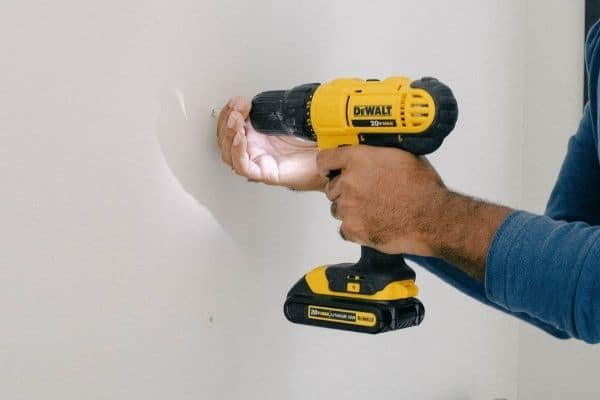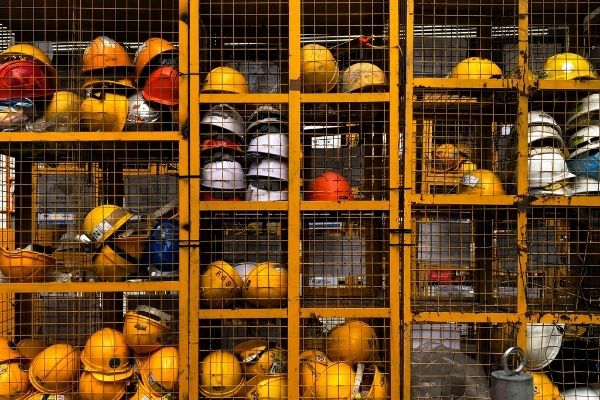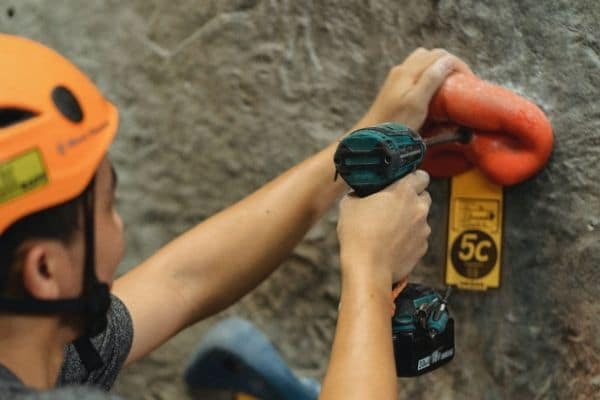
How to drill a hole in concrete article information
Loved for its aesthetic qualities by many contractors and DIYers, concrete is also known for its strength and density. Unfortunately, these traits make drilling a hole into concrete seem like boring through Ayers Rock!
The good news is, you don’t have to be a pro to drill a hole into a concrete floor, wall, or ceiling. I’ve put this guide together to show you it’s not as difficult as you think. You’ll soon be hanging mirrors, installing lighting, or even fitting a toilet faucet to the floor with the minimum stress or mess.

What Kind of Drill for Concrete?
For projects where you just need a few small holes a regular drill/driver is more than adequate. However, for more demanding materials, you should consider a hammer drill or a rotary hammer drill.
Hammer Drill
A hammer drill combines vibration or hammer action with the conventional rotational movement of a regular drill. In turn, the bit pulverizes tougher materials, like concrete, in its path while the twisting flutes of the bit evacuate the excess residue from the hole.
These machines are traditionally used for the occasional drilling of smaller holes for screws, plastic anchors, or running coaxial cable through. Even if you don’t use the hammer function now, chances are, you will at some point — especially if you plan to drill into cement, stone, or concrete.
If you want to know more, check out my 101 on hammer drills and their formats — cordless, corded.
Rotary Hammer Drill
What every hammer drill dreams of being when they grow up. Typically more expensive than its cousin and also more substantial in size, a rotary hammer drill makes drilling concrete painless. You barely need to push down as the weight of the tool alone is enough to drive it in.
This power tool operates in a way similar to a jackhammer but twists. The bit moves in a linear direction backward and forwards and drills concrete effortlessly. The rotation moves all the debris to form the hole and is ideal for clearing larger holes.
For an in-depth explanation of these brawny machines take a look at this rotary hammer drill A to Z.
What Drill Bit To Use for Concrete?
The best drill bits are masonry bits with a tip made from carbide for an even tougher cutting edge.
Rotary hammer drills will need a specialized bit called SDS or SDS Max. They’re more expensive but will last longer than traditional hammer drill bits, especially for a concrete drill.

I know you’re probably chomping at the bit (excuse the pun), but as with all drilling tasks, you should take care to wear the correct protective gear.
One major problem with drilling into masonry like cement or concrete is the presence of silica in the dust, which is known to be a carcinogen. Hence, the use of a vacuum or dust extractor is particularly worthwhile. Many rotary hammer drills either come with an attachment or a built-in dust extractor, such as the Bosch RH328VC.
So, when you drill into concrete, it’s essential you safeguard yourself from any potential risk by:
- Wearing an industrial-grade protective face mask.
- Using suitable eye protection goggles — that wrap around the face.
- Ear protectors are a must — these drills are vocal.
- Making sure the area you intend to drill is well ventilated.
- Boosting the airflow and circulation with an electric fan.
- Taking regular breaks.
- Damping down any excess dust, which may settle on the floor.
What You Will Need To Follow This Tutorial
Let’s get down to business and run through a quick checklist of all the tools and accessories you’ll need before you start your cement drill project.
- Drill (preferably a hammer drill or rotary drill).
- Carbide-tipped steel masonry bits.
- Center punch or masonry nails.
- Hammer.
- Vacuum or dust extraction attachment.
- Safety gear — mask, glasses, etc.
- Pencil or marker.
- Tape measure.
- Masking tape.
How To Drill Into Concrete Wall — Step by Step Instructions

The bit you drill-loving buddies have been waiting for — let’s make some holes!
Preparation
- First, decide where you intend to drill your hole. Take your pencil and mark your target. Then, double check your measurements to make sure it’s definitely in your desired spot before going any further.
- Now, create your drilling point. Smooth surfaces like concrete can often cause a drill bit to slip from your desired point of entry. So, grab your masonry nail or center punch and hammer, and create a tiny indent on the concrete.
- Use the depth stop on your drill bit. Adjust the drill stop to the depth of your intended hole. If your drill isn’t equipped with such a tool, use masking tape — measure the required depth on the bit and place the tape above that section.
- Don your safety gear. This includes protective goggles and a respiratory mask to prevent any dust particles from causing health problems. Ear protectors will help protect your hearing, especially with time-lengthy tasks.
- Insert your chosen carbide drill bit for the required hole size into your drill.
How To Drill Through Concrete
- Hold the drill in a recommended safety position. Hold it like a gun with one hand and your index finger on the trigger. If the drill has a side handle, secure this with your other hand. If not, hold the drill steady at the back of the unit with your spare hand.
- Make a pilot hole. Depending on how many speeds your hammer drill offers, turn your drill to the slowest speed for more control. If your drill only features one setting, drill in shorter, more controlled bursts of just a few seconds each time until you create your guide hole. This should be no more than 0.125 inches before re-drilling the hole deeper.
- Continue drilling with increasing power. Don’t apply too much pressure, just enough to cut through the concrete. Too much force will cause the bit to snap or potentially bend.
- Periodically pull the drill bit out. Bringing the drill bit back out of the hole slightly will help pull the dust out. But don’t take it all the way out, as this may enlarge the opening.
- Stop the drill occasionally to let it cool down. This is particularly important if you’re using a regular drill or a less expensive model — you don’t want to be burning that motor out mid-job.
- If you come across an especially hard piece of concrete that appears to be impenetrable — stop drilling. Instead, insert a masonry nail into the hole and tap the head with a hammer to break up the concrete blockage. Be careful not to go too deep, you’ll struggle to remove the nail. Resume drilling once the obstruction is cleared.
- Sparks may signal you have hit a rebar. If this happens, again, stop drilling straight away and switch to a rebar cutter until you pass the obstruction.
- When finished, remove any excess dust — even if you’ve been using a vacuum extractor. It will strengthen any anchors or fixings you put in your new hole. Continue to wear your goggles and face mask while doing this.
- If you have more than one hole to drill, repeat these steps.
- Give yourself a pat on the back, you’ve just conquered concrete!
If you prefer the visual approach, take a look at this short video:

The Concrete Truth About Drilling into Concrete
The best drill for concrete can save you both time, reduce your fatigue and help deliver the most secure of fixings.
So, now you know how to drill into concrete, let’s go get drilling and fixing those outside lights or wall mount that TV — maybe it’s an excuse for an even bigger TV, you know you want to! And, if you have any drill-loving buddies who you think would also find this useful, feel free to share.
How To Drill a Hole in Concrete FAQs
Q: Why Is Concrete So Hard To Drill a Hole Into?
Concrete is created by mixing very different materials — sand, crushed stones, and gravel are bonded together with cement. When combined with water it causes a reaction known as hydration. As a result, this material will often be as hard as stone.
Older concrete surfaces tend to be much harder than the newer surfaces due to the extra care that was put into the density during pouring it.
Q: Can You Use a Regular Drill To Drill Into Concrete?
While you can certainly attempt drilling into concrete with a regular drill, it will take much longer than using a hammer or rotary hammer drill. A regular drill will require more hard grunt from you rather than the power tool. And, over longer periods, the heat build-up may burn out the motor or cause the drill bit to break.
If using a regular drill you can speed up the process and avoid damage to the bit by attempting to keep it cooler. You can do this either by running cool water over the bit with cordless drills, or using a vacuum extractor hose close to the bit on corded drills.
Q: What Is the Best Drill Bit for Boring a Hole Into Concrete?
The best drill bit for drilling into concrete is a masonry drill bit.
If you’re looking at your drill bit collection and not quite sure which is a masonry bit, it’s easy to tell. These bits will have a paddle-shaped end that effectively digs out any excess dust and waste material.
Q: Do You Need a Special Drill Bit for Concrete?
With the extra strength and density of concrete, you will need a solid steel drill bit. Carbide tipped ends will provide a tougher and sharper bit to pulverize that super-strong concrete surface.
Rotary hammer drills need specialized SDS or SDS Max bits that slot in without a chuck system. These are at the top of the drill bit league and are the most robust bits available.
For more detail, check out this 101 on the different types of drill bits.
Q: Can a Cordless Drill Drill Concrete?
There’s no reason why a cordless drill shouldn’t be able to drill concrete. Most of the newer quality cordless drills offer the same power as their corded counterparts.
Aside from the hammer function, when choosing a cordless drill for drilling cement or concrete, consider the size of the battery — so you don’t run out of juice. More aggressive projects, like drilling concrete, will soon zap a battery’s strength. And, I’d suggest an 18 to 20-volt drill should offer you enough grunt.
Q: Is a Hammer Drill Necessary for Concrete?
Most people think you can’t drill into concrete without a specialized hammer drill with hardened drill bits. While this is not completely true, a hammer drill certainly makes life easier when drilling a hole in concrete.
If you must use a regular drill or the size of the project doesn’t warrant the cost of renting or buying a hammer drill, the procedure is the same as I detailed above. However, you may need more patience and a wider selection of drill bits, but it’s certainly achievable.










